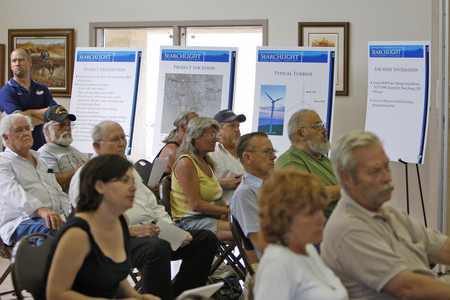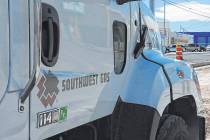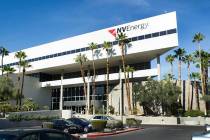Searchlight residents grill Duke Energy representatives about wind farm


The ongoing tempest over a planned wind farm swept about 10 percent of Searchlight’s 600 citizens into the town’s community center Thursday afternoon.
Searchlighters peppered executives of project developer Duke Energy with questions: What about the environmental effects of removing carbon-absorbing plants from the site? How will Duke reduce the project’s visual impact on the countryside? And why this project in their small town?
Duke officials had answers: Opening the wind farm would be like removing the carbon output of 30,000 cars from the road every year. Duke has scaled back the project’s visual fallout, reducing the number of turbines from 180 to 140, with further reductions pending. And Searchlight is ideal because it’s near transmission lines and Las Vegas, where population growth should spur power demand.
It was the latest in a string of tangles over big energy projects in Nevada, and it was a showdown with all the usual parties: public officials who want utilities to meet renewable-energy mandates; power companies looking to capitalize on government pushes for alternative power; and citizens fighting projects that would alter views, harm wildlife or affect property values.
Other projects facing recent hurdles include NV Energy’s 1,500-megawatt Ely Energy Center, a coal-fired power plant halted officially on June 15 after a years-long fight with environmentalists, and a major solar operation at the outskirts of Nellis Air Force Base’s training range. Air Force officials last week questioned the safety of locating the plant so close to the range.
The Searchlight debate began in December, when North Carolina-based Duke Energy, a Fortune 500 power giant that serves 4.5 million American households, proposed a $600 million wind farm on 24,000 acres of Bureau of Land Management property east of Searchlight, about 50 miles south of Las Vegas. Duke’s Searchlight Wind Energy Project would generate 370 megawatts of electricity — enough to power more than 90,000 homes. The 420-foot turbines would be visible from Searchlight, from U.S. Highway 95 and from parts of Lake Mohave.
Senate Majority Leader Harry Reid, D-Nev., a Searchlight native, supports the project.
"(Reid) thinks it’s a good idea," Reid spokesman Jon Summers told the Review-Journal in December. "It’s going to bring clean energy to Nevada."
Searchlight’s residents have plenty to say about the idea, too — much of it negative.
About 60 locals, the majority of them against the project, came out for Thursday’s meeting. Among their concerns: how the turbines would affect vegetation, wildlife, views, property values, quality of life, tourism, air safety, air quality, historic preservation and outdoor recreation.
Judy Bundorf, a Henderson resident who owns a Searchlight-area home with her husband, said her home would be within a mile of 10 turbines. The generators would pierce the desert peace around their 14-acre property with noise and flashing red night-lights, Bundorf told the Review-Journal before Thursday’s meeting. What’s more, she said, Searchlight has become a retirement haven for legions of seniors who couldn’t relocate away from the wind farm.
"There are a few young families living in Searchlight, but it’s mostly older people," Bundorf said. "They can’t afford to pick up and move. They mostly live in trailer houses and they’re on fixed incomes."
Robert Shawn, a member of the town’s advisory board, said he didn’t think the project was feasible. An airport is under development a mile and a half away, and the turbines could create flight hazards, he said. Plus, the bald eagles that perch in his garden could flee the countryside if the windmills come.
Town board member Eleanor Shook drew applause when she talked of leaving Southern California 13 years ago for the peace and quiet of Searchlight.
"We came here to sit on our porch, look at Spirit Mountain and hear the quiet, and now they’re going to bring it all back," Shook said. "If we all said, ‘No,’ would it do any good?"
Bob Ross, a field manager with the Bureau of Land Management, told Shook her opinion mattered.
"I want to reassure all of you that the BLM is listening very carefully," Ross said. "The amount of public comment, and the emotion behind it, is very important to us. I’ll take all of this into account as the decisionmaker."
Not everyone who spoke opposed the project.
Scott Rutledge of the Nevada Conservation League said the threat of climate change demands alternative energies such as wind power, and the Duke farm would be a better environmental choice than a coal-fired or nuclear plant.
"Don’t let perfect be the enemy of the good," Rutledge said. "America has been the biggest polluter globally. We have to turn that around. This is one of those projects where there’s an opportunity for a town like Searchlight to be part of a bigger picture."
Clark County Commissioner Steve Sisolak moderated Thursday’s meeting, taking questions from his Searchlight constituents and reading written comments of residents unable to attend. Those comments included wind-farm advocates, who said they saw the project as a route to energy independence for the United States.
Sisolak hasn’t taken a position on the Duke project, but he said he favors green power.
"I’m very supportive of renewable energy. My kids would kill me if I wasn’t," he said before the meeting. "But I don’t know the specifics of this, so this will be a learning experience for me."
The project would employ hundreds of workers during the six to eight months it would take to build it. Completed, it would employ 15 full-timers.
The wind farm remains in its earliest stages. The Bureau of Land Management is in the second of six phases involved in drafting an environmental impact statement. The bureau expects to publish a preliminary report in May. It will then accept public comments on the impact study, and incorporate that feedback into a final statement.
A Duke executive told the Review-Journal in December that the plant’s regulatory review will continue through spring 2011.
Contact reporter Jennifer Robison at jrobison@reviewjournal.com or 702-380-4512.


















